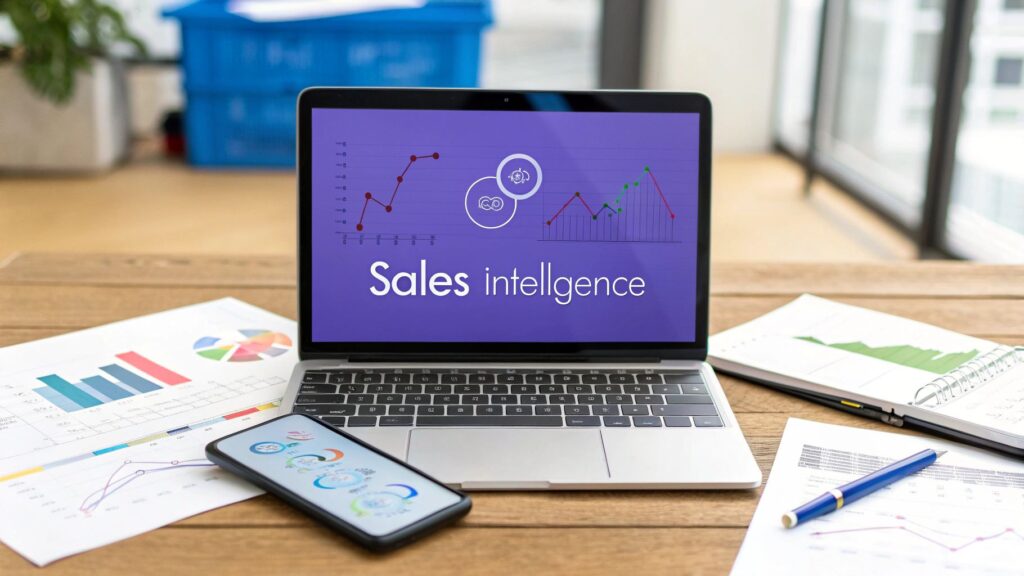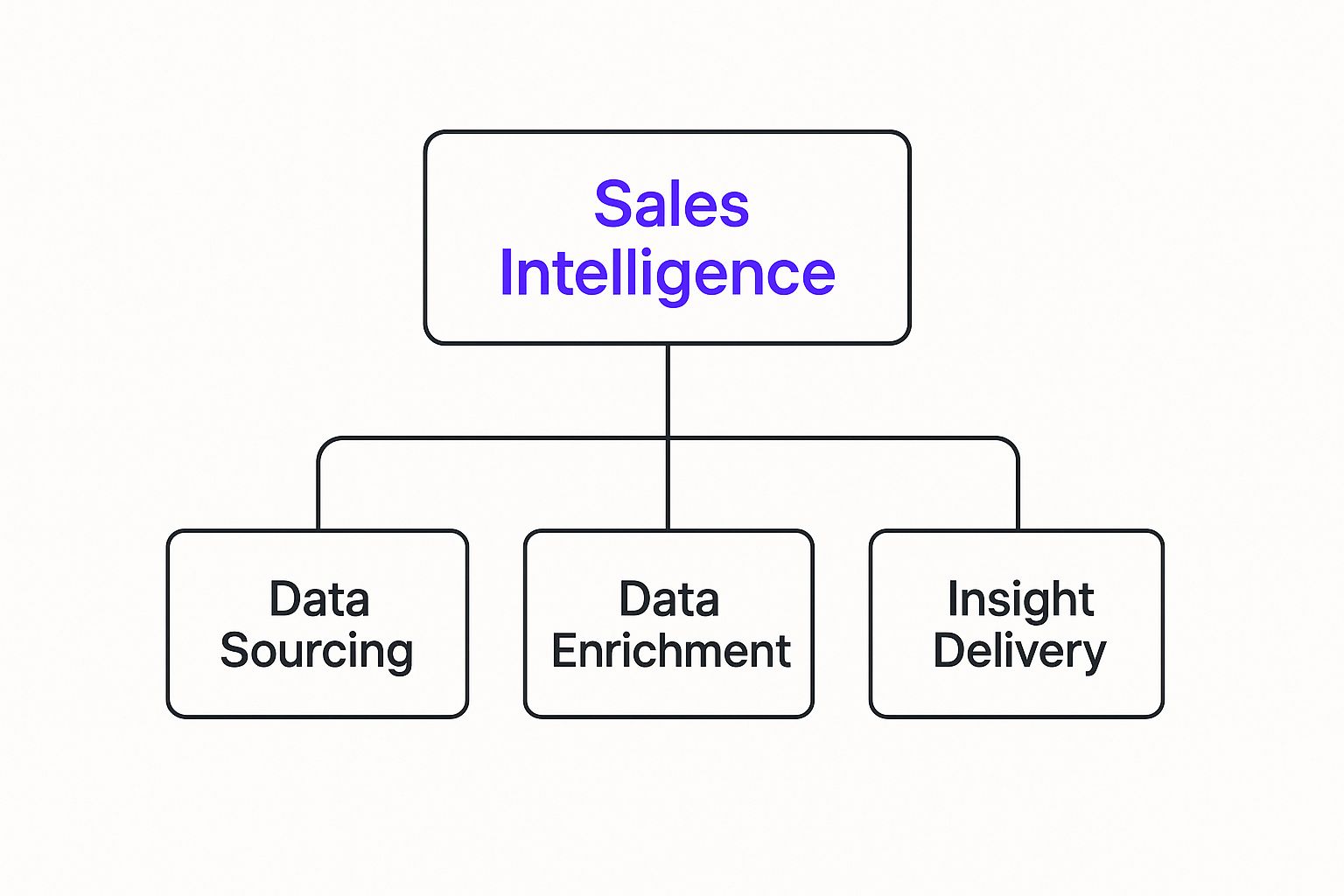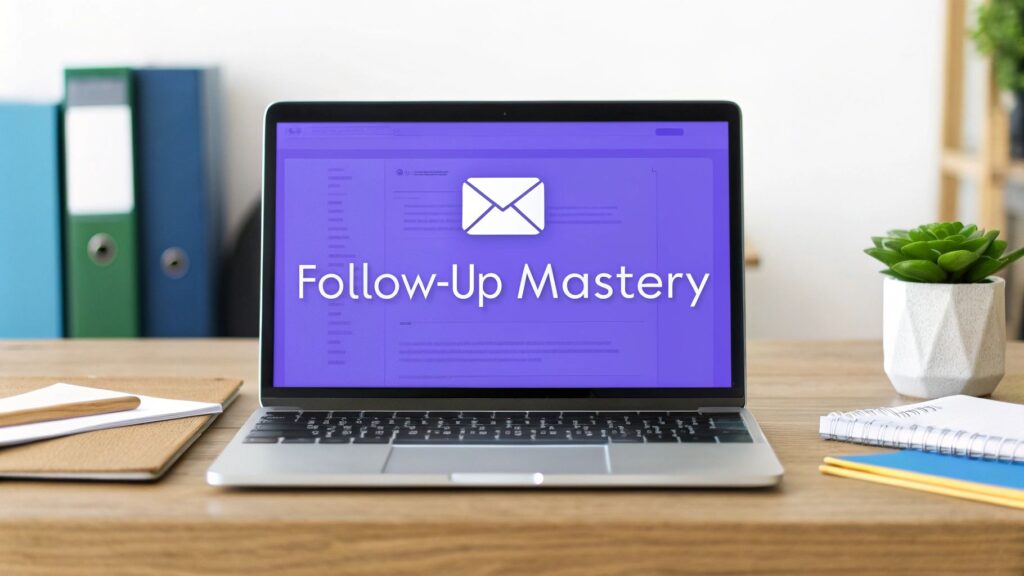What is Sales Intelligence? Boost Your Sales Strategy Today

Sales intelligence is the process of collecting, analyzing, and presenting information to help sales teams make smarter, faster decisions. It transforms the sales process from guesswork into a data-driven strategy, giving your team a significant competitive advantage.
Instead of just handing reps a list of names and numbers, sales intelligence provides actionable insights that tell them exactly who to target, when to reach out, and what to discuss. A study by Aberdeen Group found that companies using sales intelligence see 54% higher quota attainment than those who don't.
Think of it like sonar for your sales team. It helps them spot the high-value opportunities lurking just beneath the surface—the ones your competitors are completely missing.
What Is Sales Intelligence Really
Ever tried to find your way through a new city without a map? You'll probably get there eventually, but not before a lot of wrong turns and wasted time. That’s what traditional sales can feel like. Reps often rely on outdated contact lists, gut feelings, and a bit of luck.
Sales intelligence is the GPS for that journey. It provides a clear, data-driven route straight to the best prospects at the perfect moment.
It’s so much more than just a name and an email address. Sales intelligence adds critical layers of context, like:
- Firmographics: Company size, industry, location, and revenue. For example, knowing a company just hit $50 million in revenue might move them into a new target tier.
- Technographics: The software, tools, and technologies a company uses. If you sell a CRM integration, knowing a prospect uses Salesforce is a crucial piece of information.
- Buying Signals: Real-time events that indicate purchase intent, such as recent funding rounds, new executive hires, or company expansion plans.
This detailed information allows your team to stop cold calling and start having meaningful conversations with people who are actually ready to listen.
From Raw Data to Actionable Insight
The core purpose of sales intelligence is to take a mountain of raw information, refine it, and serve it to your sales reps in a way they can immediately use. This flow from messy data to a clear sales strategy is what it's all about.

This visual breaks down how disconnected bits of information are turned into a strategic advantage that guides every sales call and email. It’s a system built to give your reps a real edge.
The process involves pulling data from thousands of sources—both internal and external—to build a crystal-clear picture of your customers and the market. With over 333 million companies operating worldwide, sifting through the noise to find genuine growth opportunities is impossible without this technology.
Let's look at how this changes the game.
Old School Sales vs Intelligence-Driven Sales
The shift from traditional methods to an intelligence-led approach is stark. It’s the difference between casting a wide, hopeful net and using a high-tech fish finder to go right where the fish are.
| Aspect | Traditional Sales | Sales Intelligence |
|---|---|---|
| Approach | "Spray and Pray" mass outreach | Targeted, personalized outreach |
| Data | Stale contact lists (data decays at a rate of 22.5% per year) | Real-time, verified data with buying signals |
| Timing | Based on sales cycle, gut feeling | Triggered by prospect actions (e.g., website visit, job posting) |
| Conversation | Generic, one-size-fits-all pitch | Highly relevant and contextual |
| Efficiency | High volume, low conversion | Higher quality interactions, better conversion rates |
As you can see, sales intelligence doesn't just improve the old way; it fundamentally changes the way you sell for the better.
At its core, sales intelligence is about replacing the "spray and pray" approach with surgical precision. It ensures every outreach effort is timely, personalized, and directed at a prospect who is more likely to buy.
A huge part of that precision comes from truly understanding what is lead qualification, a process that’s supercharged by good data. While it shares some DNA with market analysis, sales intelligence is much more tactical—it’s focused on specific accounts and contacts. For a look at the bigger picture, check out our guide on what is competitive intelligence.
Ultimately, sales intelligence gives your team more than just data. It gives them the confidence to act on it.
The Three Pillars of Sales Intelligence
A truly effective sales intelligence strategy isn't just about collecting data—it's about building a system that turns that data into revenue. This system rests on three core pillars that work in tandem, transforming bits and pieces of information into perfectly timed sales opportunities.

Getting a handle on these pillars makes it much clearer what sales intelligence actually is and how it works. Each one plays a vital role in giving your sales team the edge they need to close more deals.
Pillar 1: Data Sourcing
The first pillar is Data Sourcing. This is all about gathering the raw ingredients. Information gets pulled from thousands of public and private sources to start building a detailed picture of your potential customers. It’s the foundation for everything that follows.
What kind of data are we talking about?
- Firmographics: The basic company stats—industry, employee count, annual revenue. This is how you quickly figure out if a company even fits your ideal customer profile.
- Technographics: The technologies a company is already using. For example, knowing a prospect uses HubSpot and Slack allows you to tailor a pitch around integration and workflow improvements.
- Buying Signals: These are the real game-changers. Think of them as real-time events that scream, "This company is ready to buy!" A recent funding announcement, a hiring spree for a specific role, or a big jump in ad spending are all powerful signals.
This initial data haul gives you the basic context, but on its own, it’s often a messy and incomplete puzzle. That's where the second pillar comes in.
Pillar 2: Data Enrichment
Next up is Data Enrichment, which is the process of refining all that raw material. Think of it like a chef prepping ingredients—you wash the vegetables, trim the fat, and get everything ready for the main course. Data enrichment cleans, verifies, and fills in the gaps in your sourced information.
This pillar is where accuracy is born. Without solid enrichment, your sales team will waste countless hours chasing bad phone numbers, emailing bounced addresses, and pitching people who left their jobs months ago. A recent report found that 40% of sales reps feel they don't have enough information before making a sales call. Enrichment solves this.
Enrichment makes sure the information isn't just there, but that it's right. It confirms an email address is active or validates that a contact's job title and company are up-to-date. This step is so critical that many businesses use dedicated solutions to get it right. You can see how this works by checking out some of the best data enrichment tools available today.
Pillar 3: Insight Delivery
Finally, we have Insight Delivery. This is the "last mile" where all that refined, actionable intelligence actually gets to your sales reps right when they need it most. After all, the most brilliant data in the world is useless if it’s buried in a clunky dashboard nobody ever looks at.
Effective delivery means the insights flow seamlessly into a salesperson's daily routine, usually right inside their Customer Relationship Management (CRM) platform. Instead of having to hunt for information, it just shows up on the contact or account record they're already looking at. This gives them the context they need to make every single interaction personal, turning a dreaded cold call into a warm, well-informed conversation.
How Sales Intelligence Actually Grows Your Business
Let's get one thing straight: sales intelligence isn't just about collecting interesting tidbits of data. It’s about turning that information into real, measurable results. When your teams stop guessing and start operating with a data-backed strategy, the effect on your revenue, efficiency, and customer relationships is massive.
This shift is why the market is exploding. The global sales intelligence market is already valued at around USD 4.5 billion and is expected to jump to a staggering USD 11.7 billion by 2035. Why the boom? Because businesses are seeing the undeniable, tangible benefits of using these tools. You can find more insights about the sales intelligence market and its projected growth.

Nail Your Outreach With Hyper-Personalization
One of the first things you'll notice is the power to personalize outreach on a massive scale. Let's be honest, generic, one-size-fits-all emails are dead on arrival. In fact, 80% of buyers are more likely to purchase from a company that offers personalized experiences. Sales intelligence platforms act like a radar, alerting your reps to specific buying signals that create a genuine window of opportunity.
Imagine your rep gets a notification that a target company just brought on a new VP of Marketing. Instead of firing off a generic pitch, they can send a perfectly timed message: "Congrats on the new role! As you're settling in and probably re-evaluating your marketing stack, I thought you might find this case study on [relevant topic] useful." It's relevant, it's timely, and it shows you've done your homework.
Drastically Shrink Your Sales Cycles
How many deals have you seen stall because your team was talking to the wrong person? It happens all the time. A deal can get stuck in limbo for weeks—or even months—waiting for a sign-off from some mystery decision-maker no one knew existed.
Sales intelligence completely changes this dynamic by helping you map out the entire buying committee right from the start. Today's average B2B buying group involves 6 to 10 decision-makers. Trying to navigate that without a map is a recipe for delay.
By identifying the whole group of influencers and budget holders, not just a single contact, your reps can build consensus across the organization from day one. This proactive approach prevents last-minute surprises and keeps the deal moving, dramatically cutting down the time from that first hello to a signed contract.
At its core, sales intelligence is all about removing friction. It provides clarity on who to talk to, when to reach out, and what to say, which directly speeds up revenue generation.
Boost Lead Conversion and Forecast with Confidence
Finally, sales intelligence fuels growth in two other game-changing ways:
- Sky-high Lead Conversion Rates: By focusing all their energy on prospects that perfectly match your ideal customer profile, sales teams stop wasting time on dead ends. This laser focus means the leads they do work are far more likely to become happy, paying customers.
- Rock-Solid Sales Forecasting: Gut feelings are out; objective data is in. With clear insight into historical trends, engagement metrics, and deal progression, sales leaders can build revenue forecasts you can actually count on. This allows for smarter strategic planning across the entire business.
Putting Sales Intelligence into Practice
https://www.youtube.com/embed/Ts42JTye-AI
It’s one thing to talk about sales intelligence in theory, but where the rubber really meets the road is seeing it in action. This isn't just about collecting data; it's about using that information to tackle real-world sales problems and open up new doors for revenue.
Let's walk through a few common scenarios. You'll see a clear pattern: a business runs into a wall, intelligence provides the breakthrough, and the result is a direct impact on the bottom line. This is how raw data becomes a strategic playbook for your sales team.
Strategic Account Targeting
Imagine a B2B marketing agency with a classic problem: their outreach is all over the place. They’re burning time and money, and their response rates are disappointingly low. They know their ideal customers use specific marketing automation tools, but finding them feels like throwing darts in a dark room.
This is where technographic data completely changes the game.
- The Problem: Wasting effort on prospects who aren’t a good technological fit from the start.
- The Solution: The agency uses a sales intelligence tool to build a laser-focused list. They filter for companies using software like Marketo or Pardot that also show signs of a weak SEO strategy. Suddenly, they have a list of pre-qualified businesses practically raising their hands.
- The Outcome: The sales team's outreach is instantly more powerful. Instead of a generic "Hey, we do marketing," their message becomes, "We noticed you're using Marketo and can help you get more value from it by driving qualified traffic to your landing pages." That kind of relevance gets replies and fills the pipeline with perfect-fit clients.
The big idea here is to stop shouting at everyone and start having meaningful conversations with the right companies. Intelligence gives you the focus to make every single sales activity matter.
Identifying Expansion Opportunities
Here's another familiar story: a SaaS company has a decent list of customers but can't seem to grow those accounts. They wait for the annual renewal to talk about upgrades, completely missing the best moments to expand.
With sales intelligence, they can flip the script from reactive to proactive.
- The Problem: Leaving serious upsell and cross-sell revenue on the table with existing customers.
- The Solution: The team sets up alerts to monitor their clients for key growth signals. These triggers could be a hiring spree for a specific department, a new round of funding, a recent company acquisition, or a major spike in website traffic.
- The Outcome: An alert pops up—a current customer is hiring 10 new salespeople. The account manager gets on the phone immediately to discuss upgrading their plan to include more seats. They're solving a problem at the exact moment the customer is feeling the pain, which makes the conversation natural and effective. This approach significantly boosts customer lifetime value.
Displacing Your Competitors
Trying to win an account from a competitor is a tough hill to climb. A standard pitch rarely works because, from the prospect's perspective, there's no compelling reason to go through the hassle of switching.
Sales intelligence helps you find the cracks in your competitor's armor. By tracking signals of dissatisfaction—like negative comments on social media or key executives at a target account suddenly connecting with rival salespeople on LinkedIn—you can spot an opening.
Combining this intel with solid sales prospecting best practices helps refine your timing and messaging. It’s all about showing up with a better alternative at the exact moment they’re starting to look for one. And of course, knowing how to qualify sales leads ensures you’re not chasing ghosts, but focusing on competitor accounts that are genuinely ready for a change.
Common Sales Intelligence Plays
To bring it all together, here are a few practical "plays" your team can run using sales intelligence. Each one starts with a clear goal and uses specific data points to achieve a measurable business outcome.
| Use Case | Primary Goal | Key Data Points Needed | Expected Business Outcome |
|---|---|---|---|
| Ideal Customer Profile (ICP) Targeting | Find net-new accounts that mirror your best customers. | Firmographics (industry, size, location), Technographics (current tech stack), Intent Data (actively researching your solution). | Higher quality leads, increased conversion rates, shorter sales cycles. |
| Proactive Account Expansion | Identify upsell or cross-sell opportunities within the existing customer base. | Growth signals (hiring surges, funding news, new office locations), Usage data (nearing plan limits). | Increased Customer Lifetime Value (CLV), improved Net Revenue Retention (NRR). |
| Competitor Displacement | Win business from entrenched competitors. | Dissatisfaction signals (negative online mentions), Contract renewal dates, Executive job changes. | Increased market share, acquisition of high-value strategic accounts. |
| Market Entry Strategy | Validate and prioritize new geographic or industry verticals. | Total Addressable Market (TAM) data, Technographic penetration, Competitor density in the new market. | Reduced risk for market expansion, faster time-to-revenue in new territories. |
These plays aren't just theoretical; they are the day-to-day blocking and tackling that top-performing sales organizations use to consistently hit their numbers. By turning data into action, you create a system for repeatable success.
Choosing the Right Sales Intelligence Platform
Picking the right sales intelligence platform is a big deal. It's a decision that can make or break your team's effectiveness. With so many options out there, it’s easy to get lost in a sea of features and flashy marketing. Let’s cut through the noise and build a simple framework for figuring out which tool will actually help you close more deals.

Forget the one with the longest feature list. The best platform is the one that gives your team accurate, relevant data in a way that’s easy to use. It's about finding the tool that slots right into your workflow and starts generating revenue, not headaches.
Data Accuracy and Scope
First things first: the data has to be good. This is the absolute foundation. If the information is wrong or old, you're not just wasting time—you're actively damaging your reputation. Every bounced email or call to someone who left the company six months ago chips away at your credibility.
When you're looking at a platform, you need to be a detective. Ask tough questions:
- How do they verify their data? Find out how often they refresh contact info and company details. Do they use AI, human verification, or a mix of both?
- Does their data cover your turf? If you sell to a niche industry or a specific part of the world, make sure the tool has deep, reliable coverage there. Request a sample list for your target segment.
- Are the buying signals actually useful? The platform should track the triggers that matter to you, whether that’s a recent funding round, a key executive hire, or a new tech installation.
A smaller, ultra-accurate database focused on your ideal customer is a thousand times more valuable than a massive, messy list of outdated contacts. When it comes to sales data, precision always beats volume.
Seamless CRM Integration and Usability
The most brilliant data on earth is useless if your team can’t get to it easily. The whole point is to weave intelligence into your sales process, not to add another complicated tool to the stack. This is why CRM integration and overall ease of use are non-negotiable.
A great platform should feel like it's part of your CRM, not a clunky add-on. Data should flow smoothly into your contact and account records, enriching them without anyone having to lift a finger. If a tool makes your reps do a ton of manual data entry or requires weeks of training, they just won't use it. High user adoption is the key to ROI.
This is becoming more important than ever. North America is the biggest player in the sales intelligence game, holding up to 46% of the global market share. That market is expected to jump from USD 1.07 billion to around USD 2.93 billion by 2034. As more businesses adopt these tools, the ones that are simple to implement and use will win. You can explore more sales intelligence market forecasts to see how things are shaping up globally.
Scalable and Transparent Pricing
Last but not least, let's talk about money. You have to understand how you're going to pay for this thing. Stay away from platforms with confusing pricing tiers that feel designed to trap you.
Look for a pricing model that can grow with you. Whether you're a small agency of five or an enterprise team of 500, the cost should make sense and scale predictably. The value you get should always be crystal clear. A straightforward pricing structure means you can confidently measure your ROI and plan for the future without any nasty surprises on your invoice.
Answering Your Questions About Sales Intelligence
Even after laying out the strategy, it's natural to have a few questions about how sales intelligence works in the real world. Let's dig into some of the most common ones to paint a clearer picture of how these tools can fit into your day-to-day and actually drive growth.
How Is Sales Intelligence Different From My CRM?
This is a great question, and it gets to the heart of the matter. The two are closely related, but they play very different roles.
Think of your Customer Relationship Management (CRM) platform like your team's perfectly organized digital address book. It holds all the information you've gathered from direct interactions—every phone call, email, and meeting note is logged right where it should be. It’s your internal history.
Sales intelligence, on the other hand, is like your external reconnaissance team. It goes out into the world to find new, timely information to add context to that address book. It enriches the data you already have with crucial details you couldn't find on your own.
Your CRM tells you what you know about your contacts. Sales intelligence tells you what you need to know about them right now—even if you've never spoken to them.
For instance, your CRM might list a contact's job title from six months ago. A sales intelligence platform will flag that they were just promoted last week, giving you a perfect, non-generic reason to reach out. Your CRM is your system of record; sales intelligence is your system of insight.
What Are the First Steps to Getting Started?
Bringing a sales intelligence tool on board is less about the tech and more about the strategy. Before you even book a demo, you need to have a rock-solid idea of what you’re trying to accomplish.
Here’s where to start:
- Nail Down Your Ideal Customer Profile (ICP): Get specific. What industry, company size, and location define your absolute best customers? What tech stack do they use?
- Pinpoint Your Key Buying Signals: What events signal that a company is ready to hear from you? This could be anything from a new round of funding to a key executive hire or an upcoming contract renewal with a competitor.
- Plug It Into Your CRM: Make this connection on day one. When data flows seamlessly into your sales team’s existing workflow, adoption becomes a breeze instead of a battle.
- Launch With a Few Simple "Plays": Don't throw a hundred new features at your team. Start with two or three high-impact sales plays, like targeting companies that just hired a new CMO or reaching out to businesses that recently announced an expansion.
How Can I Actually Measure the ROI?
Proving the value of any new tool is non-negotiable. Luckily, the impact of sales intelligence is easy to track if you focus on the right key performance indicators (KPIs).
- Higher Lead Conversion Rates: Are you turning more leads into real, qualified opportunities? Compare the conversion rates of leads you found or enriched with the tool versus those you didn't.
- Shorter Sales Cycles: Is your team closing deals faster? Measure the average time from that first conversation to a signed deal. A good tool should help shorten that window.
- Bigger Deal Sizes: Better intel often reveals bigger opportunities. In fact, one study showed that companies using sales intelligence see a 15% increase in their average contract value.
- More Productive Sales Reps: How much time are you saving on grunt work? Ask your reps how many hours they're getting back each week now that they aren't manually digging for information. That’s time they can spend selling.
Is This Stuff Only for Big Companies?
Not a chance. This is probably the biggest myth out there. While huge enterprise sales teams definitely get a lot of value from these tools, you could argue they're even more critical for smaller businesses and agencies.
If you're a startup or an SMB, your resources are tight. Every hour a salesperson wastes on manual prospecting is an hour they aren't talking to potential customers. Sales intelligence levels the playing field, giving smaller teams the ability to find and qualify top-tier leads with the same precision as their massive competitors. It automates the drudgery, freeing up your team to do what they do best: build relationships and close business.
Ready to stop guessing and start targeting high-intent leads? FundedIQ delivers monthly lists of recently funded startups, complete with verified decision-maker contacts and critical buying signals. Skip the research and get straight to pitching prospects who are ready to invest in growth. Get your first list of actionable leads at https://fundediq.co.





